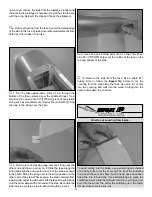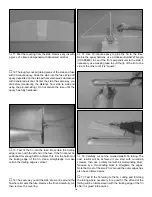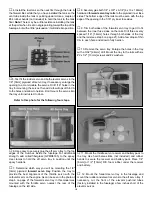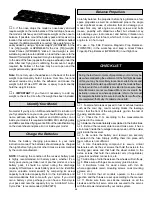
❏
15. Apply 1/4" [6mm] Kwik Stripe silver striping tape
(GPMQ1244) around the windscreens where they meet
the fuse.
❏
16. Cut out the molded dorsal fin, then use thin or
medium CA to glue it into position as shown.
1. Use scissors or a sharp hobby knife to cut the decals from
the sheet.
2. Be certain the model is clean and free from oily fingerprints
and dust. Prepare a dishpan or small bucket with a mixture of
liquid dish soap and warm water–about one teaspoon of
soap per gallon of water. Submerse the decal in the soap and
water and peel off the paper backing. Note: Even though the
decals have a “sticky-back” and are not the water transfer
type, submersing them in soap and water allows accurate
positioning and reduces air bubbles underneath.
3. Position decal on the model where desired. Holding the
decal down, use a paper towel to wipe most of the water away.
4. Use a piece of soft balsa or something similar to
squeegee remaining water from under the decal. Apply the
rest of the decals the same way. It is best to allow the decals
to “set” overnight before flying the model.
❏
1. Connect the aileron servo wires with a “Y” connector.
For the following steps the aileron servos need to be
connected to the receiver, but it's easier to operate with the
wing off the fuselage. Place the wing on a stand next to the
fuselage, then connect the “Y” connector from the ailerons to
a servo extension cord and connect the cord to the receiver.
❏
2. Turn on the transmitter and receiver and center the
trims. Remove any servo arms that aren't centered and
reposition them so they are centered. Reinstall the screw
that holds on the servo arm.
❏
3. If necessary, adjust the clevises on the pushrods so
the control surfaces are centered. Be certain to tighten the
nuts on the metal clevises on the elevator and rudder.
❏
4. Make certain the control surfaces and the carburetor
respond in the correct direction as shown in the diagram. If any
of the controls respond in the opposite direction, change their
direction by using the servo reversing feature in your transmitter.
❏
5. Use a Great Planes AccuThrow
™
(or a ruler) to
accurately measure and set the control throw of each control
surface as indicated in the chart that follows. If your radio
does not have dual rates, we recommend setting the throws
at the low rate setting.
CARBURETOR WIDE OPEN
RUDDER MOVES RIGHT
LEFT AILERON MOVES DOWN
RIGHT AILERON MOVES UP
ELEVATOR MOVES UP
4-CHANNEL
TRANSMITTER
(STANDARD MODE 2)
4-CHANNEL RADIO SETUP
TRANSMITTER
4-CHANNEL
TRANSMITTER
4-CHANNEL
TRANSMITTER
4-CHANNEL
Set the Control Throws
PREPARE THE MODEL FOR FLYING
Apply the Decals
27






































